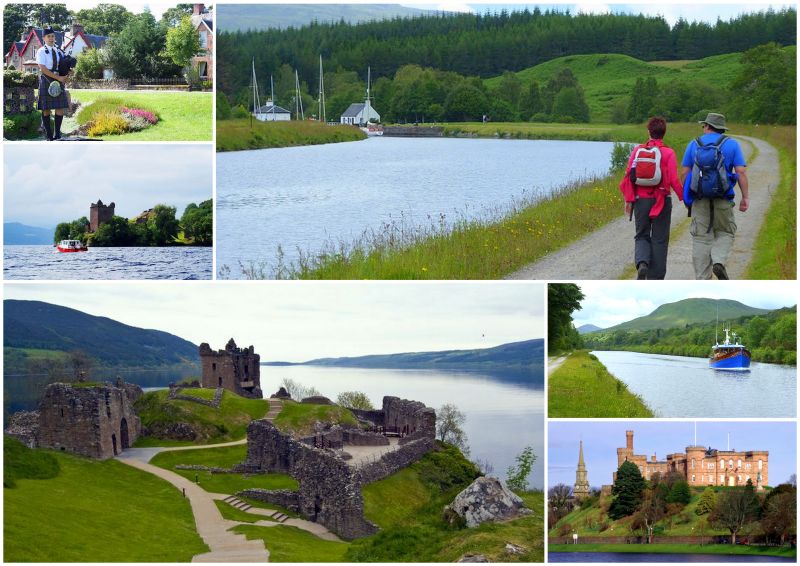
Great Glen Way: Trail Info
Introduction
The Great Glen Way, which was opened in 2002, is one of Scotland's official Great Trails. It stretches for 127km (79 miles) from coast to coast across the Scottish Highlands, from Fort William in the west to Inverness in the east. The trail is generally walked from west to east to follow the direction of the prevailing wind. It follows the geological fault of the Great Glen and is home to some of Scotland's most spectacular and atmospheric scenery. It runs along the complete lengths of Loch Linnhe, Loch Oich and the forests above Loch Ness (a great vantage point to try to spot the Loch Ness Monster!), as well as along the towpath of the Caledonian Canal.
On the Caledonian Canal, just outside of Fort William, you will pass ‘Neptune’s Staircase’, a staircase lock comprising of eight locks, and named for the Roman god of freshwater and the sea. It is the longest staircase lock in the UK. And for those who are fans of history, you will have the opportunity to learn about the Jacobites, Loch Ness and visit Urquhart Castle, which has a bloody history from 1200s – 1600s, and remains an excellent example of a medieval stronghold.
Map
The Route
The walk starts from the edge of Loch Linnhe in Fort William, a sea loch that opens out onto the Atlantic Ocean. It follows the line of the Caledonian Canal for most of the way. This canal opens out into Loch Lochy, at Gairlochy, north-east of Fort William. Once past Loch Lochy, you will pass through Laggan, before arriving to Loch Oich. You will pass Loch Oich, and continue to follow the path of the canal to Fort Augustus, which lies at the southwestern end of Loch Ness.
The route follows the northern shore of Loch Ness to Invermoriston, and onwards to Drumnadrochit. The way leaves the shores of Loch Ness and heads west, shortly after Drumnadrochit, and takes a moor and farmland route before crossing the Caledonian Canal and the River Ness as the walk enters the city of Inverness. From here, both the canal and the river have no more than two miles left to run before they enter the sea at the Moray Firth.
Terrain Overview
Much of the route follows forest tracks and roads as well as the well-maintained and mostly level towpaths of the Caledonian Canal. The new higher route options (from Fort Augustus to Invermoriston, and Invermosiston to Drumnadrochit) offer a more challenging walking experience with more climbs and slightly more rugged terrain. The high level moorland around Blackfold between Drumnadrochit and Inverness can be exposed to the elements.
Aggregate ascent over the whole route is approximately 2,600m, and there are very few sustained or steep climbs. The highest point on the Way is 422m above sea level, on the slopes of Creag Dhearg, which is just above Alltsigh.
Elevation Profile (Click image to enlarge)
Terrain by Stages
Fort William – Gairlochy: Quiet roads and paths out of Fort William. Then a well-maintained canal towpath as far as Gairlochy.
Gairlochy – Laggan/Invergarry: Some initial walking on a minor road followed by forestry tracks. At the end of this section there is a narrow path through Laggan that can be muddy at times.
Laggan – Fort Augustus: Level section along an old railway line then grass paths along the side of Loch Oich which can sometimes be muddy. To finish, an easy level walk on a well-formed canal towpath leads into Fort Augustus.
Invergarry – Fort Augustus: Steep climb out of Invergarry. Forest trails initially then a canal towpath from the Bridge of Oich.
Fort Augustus – Invermoriston
(High Route): Tracks, minor roads and paths throughout; some steep ascents and descents. The path can be narrow in parts and follows grass paths but mainly it is on well-maintained forest tracks.
(Low Route): Forest tracks and paths with some short, steep slopes.
Invermoriston – Drumnadrochit
(High Route): Tracks, minor roads and paths throughout; some steep ascents and descents. The way is generally on well-laid forest tracks and minor roads but there are some sections where the pathway is narrow and on grass and stones.
(Low Route): Steep climb to start, then gentle slopes with forest tracks and moorland road.
Drumnadrochit – Blackfold: A mixture of surfaces from woodland paths to minor roads and moorland tracks. There are some inclines but none as demanding as the previous two sections. The high level moorland on the way to Blackfold can be exposed.
Blackfold – Drumnadrochit: Walk on minor roads to begin, followed by forest and moorland tracks. Descent into Drumnadrochit. The high level moorland on the way from Blackfold can be exposed.
Blackfold – Inverness: Forest paths and tracks; then well-surfaced paths through parks and urban green areas.





